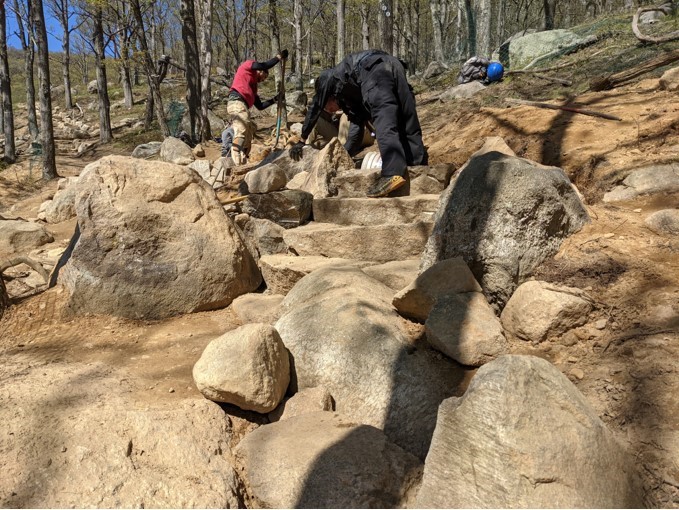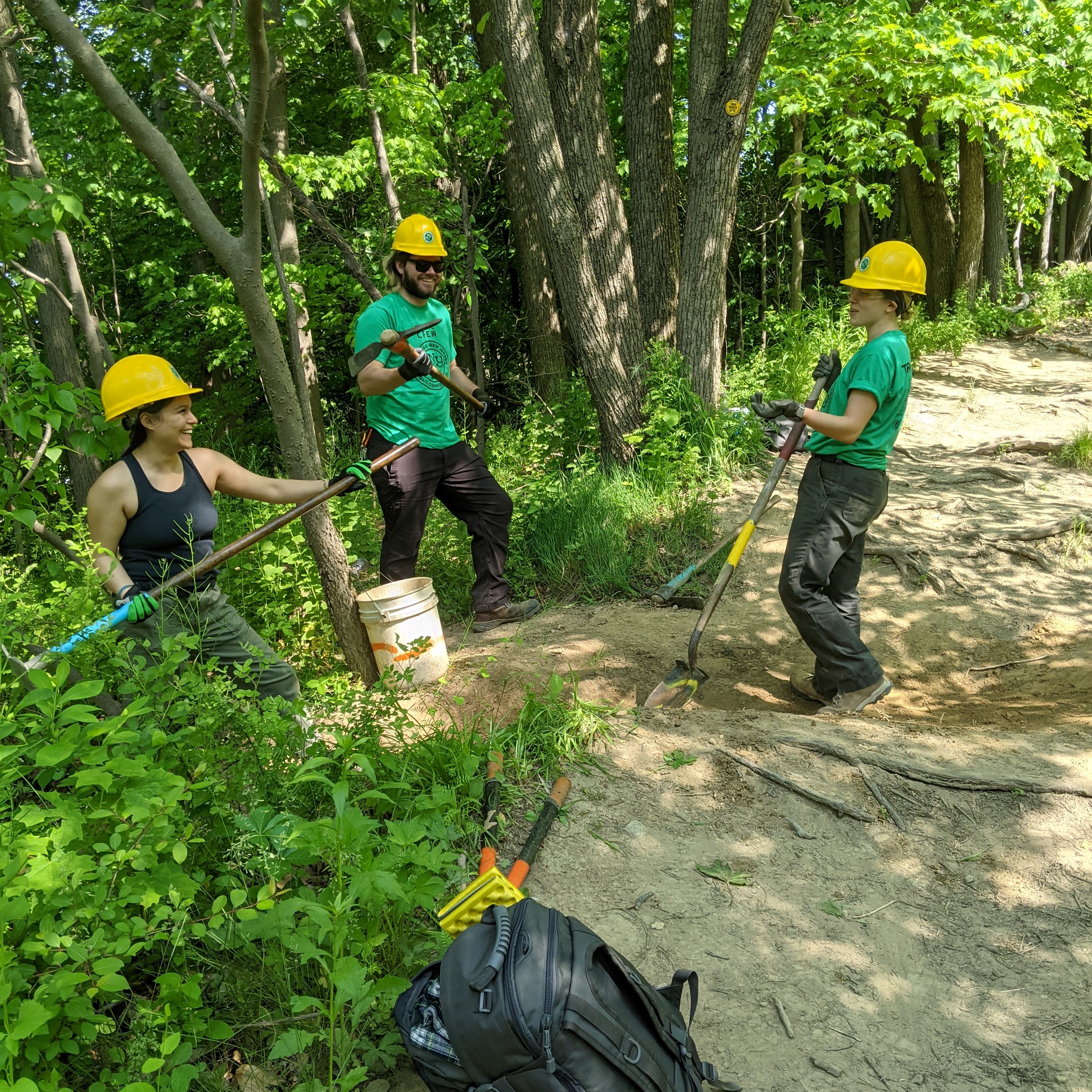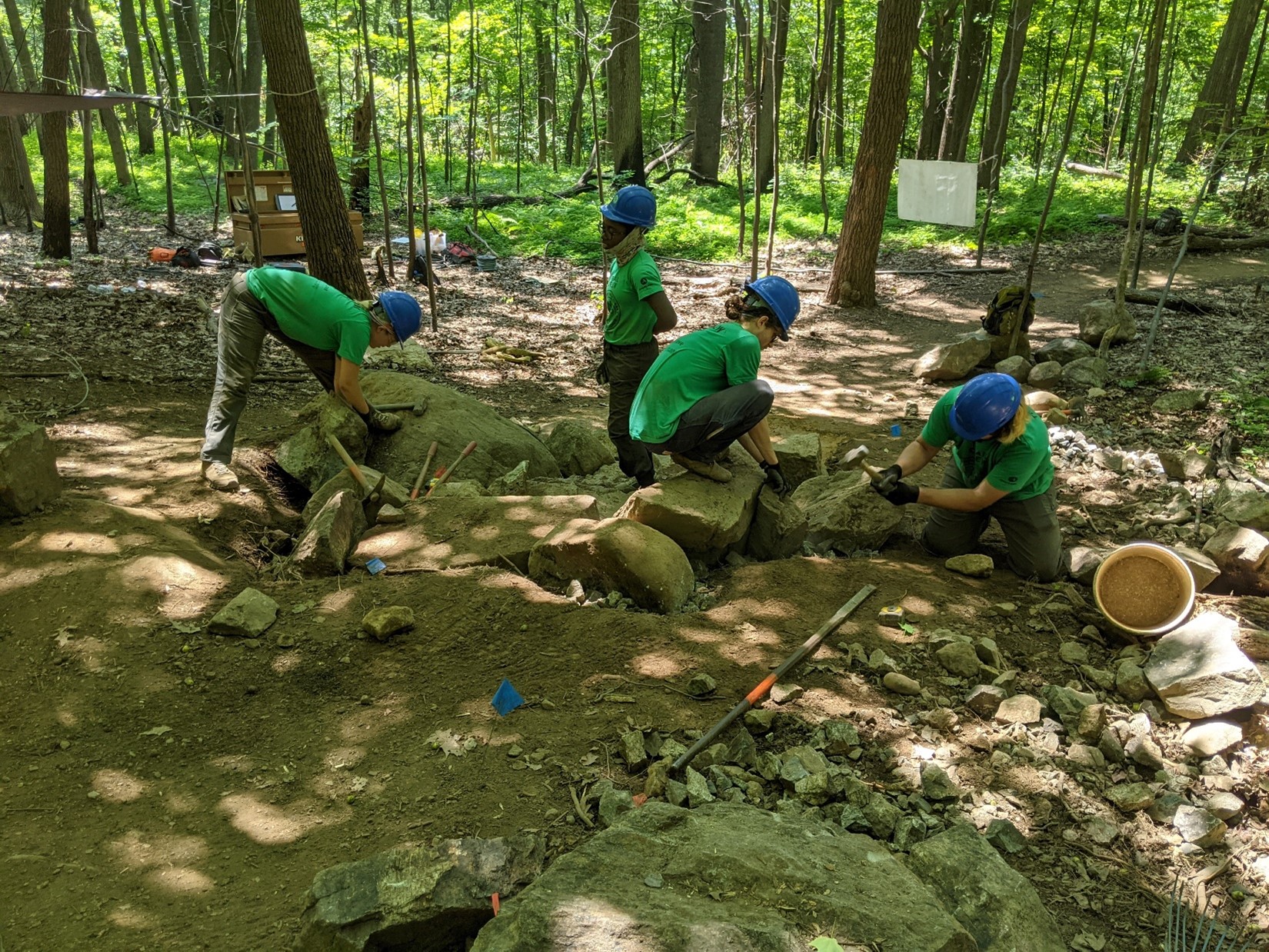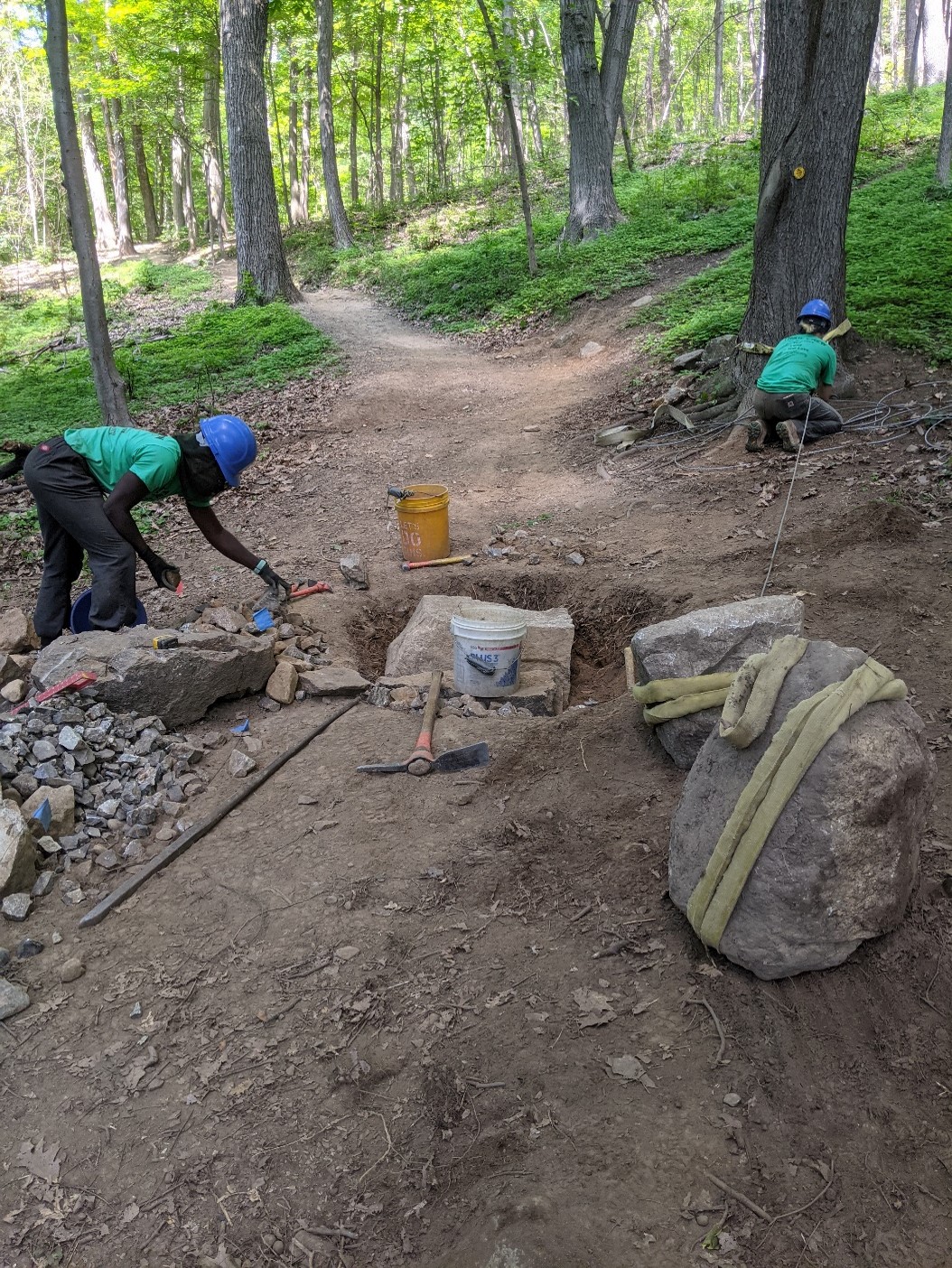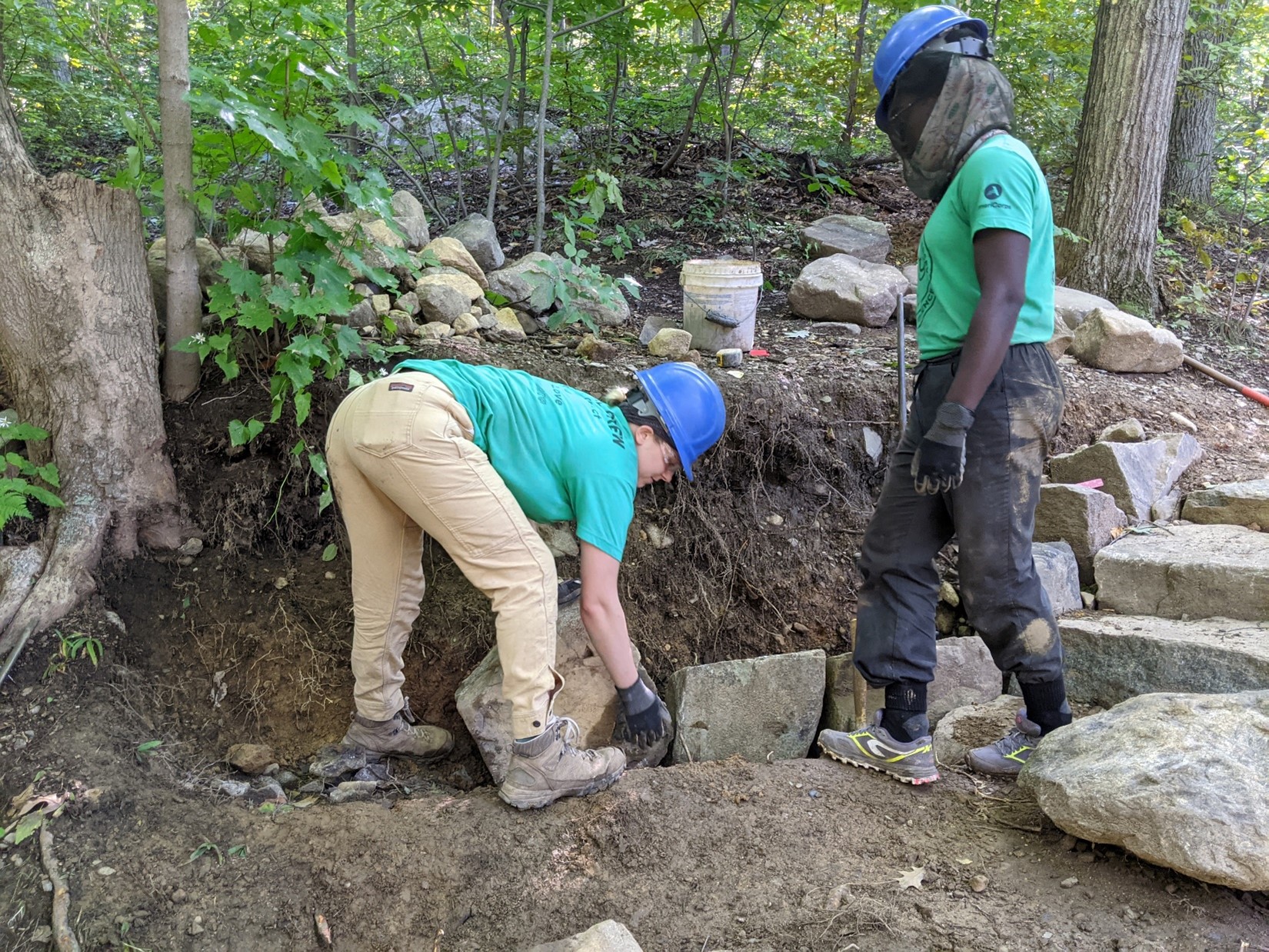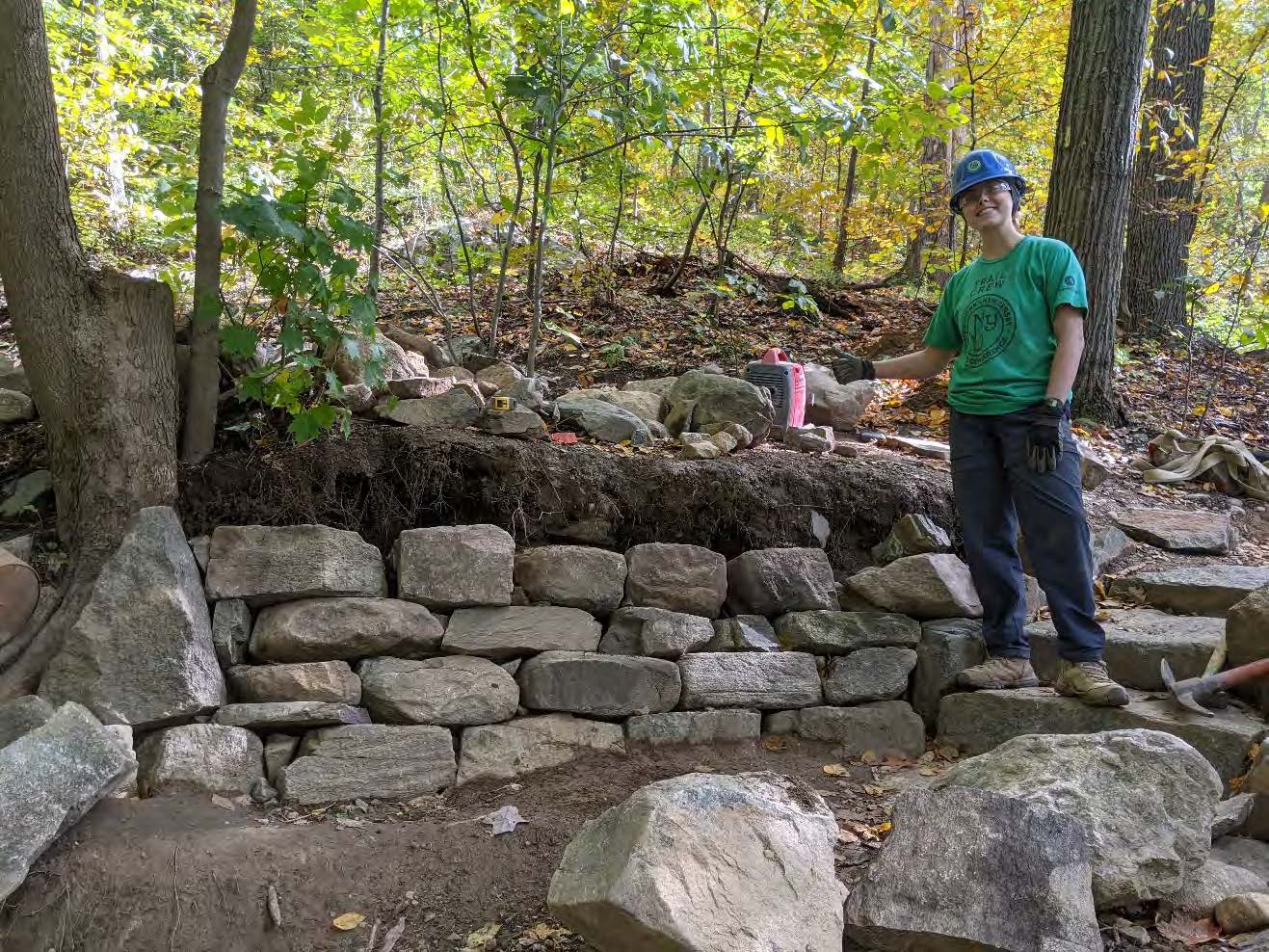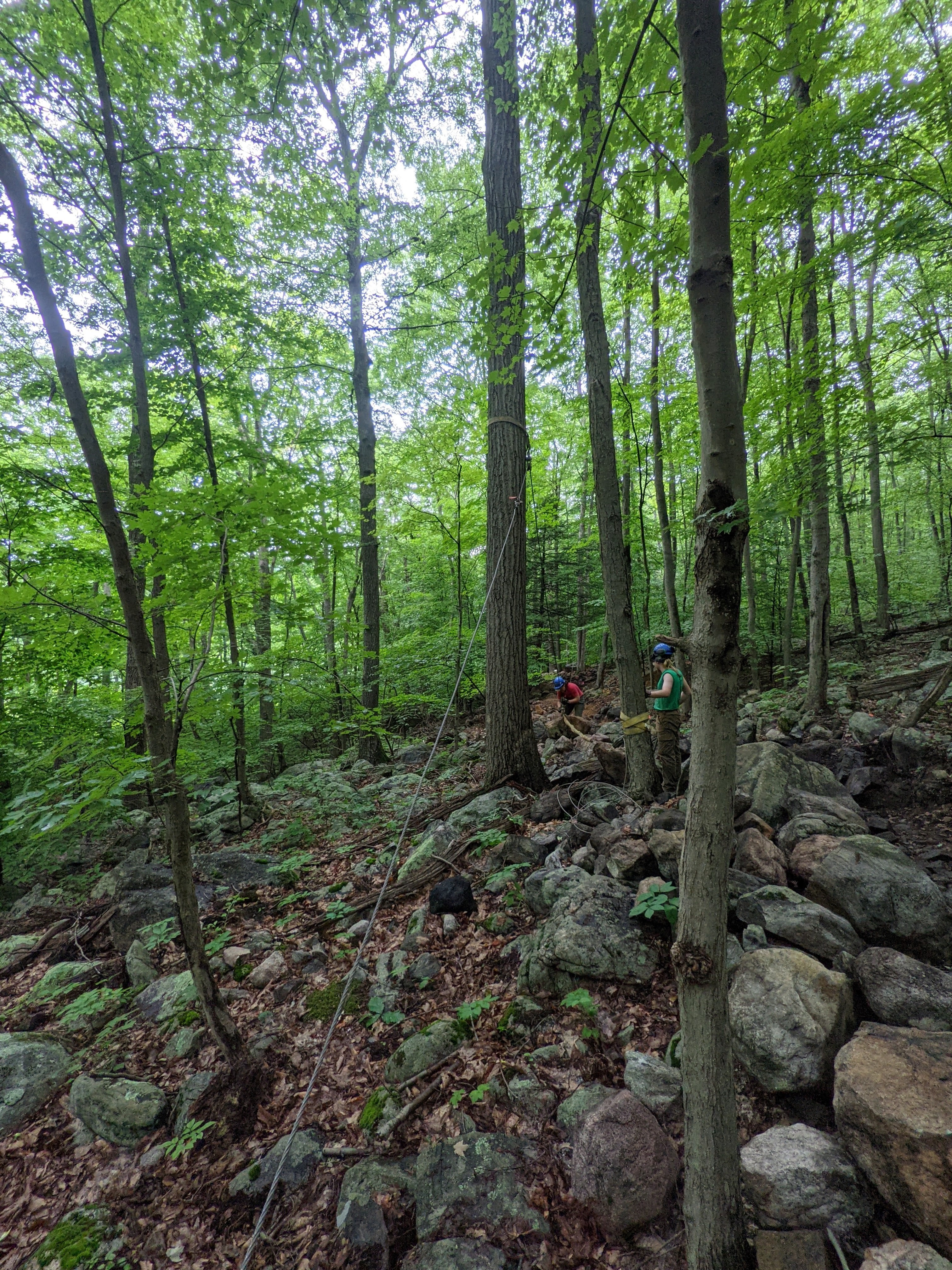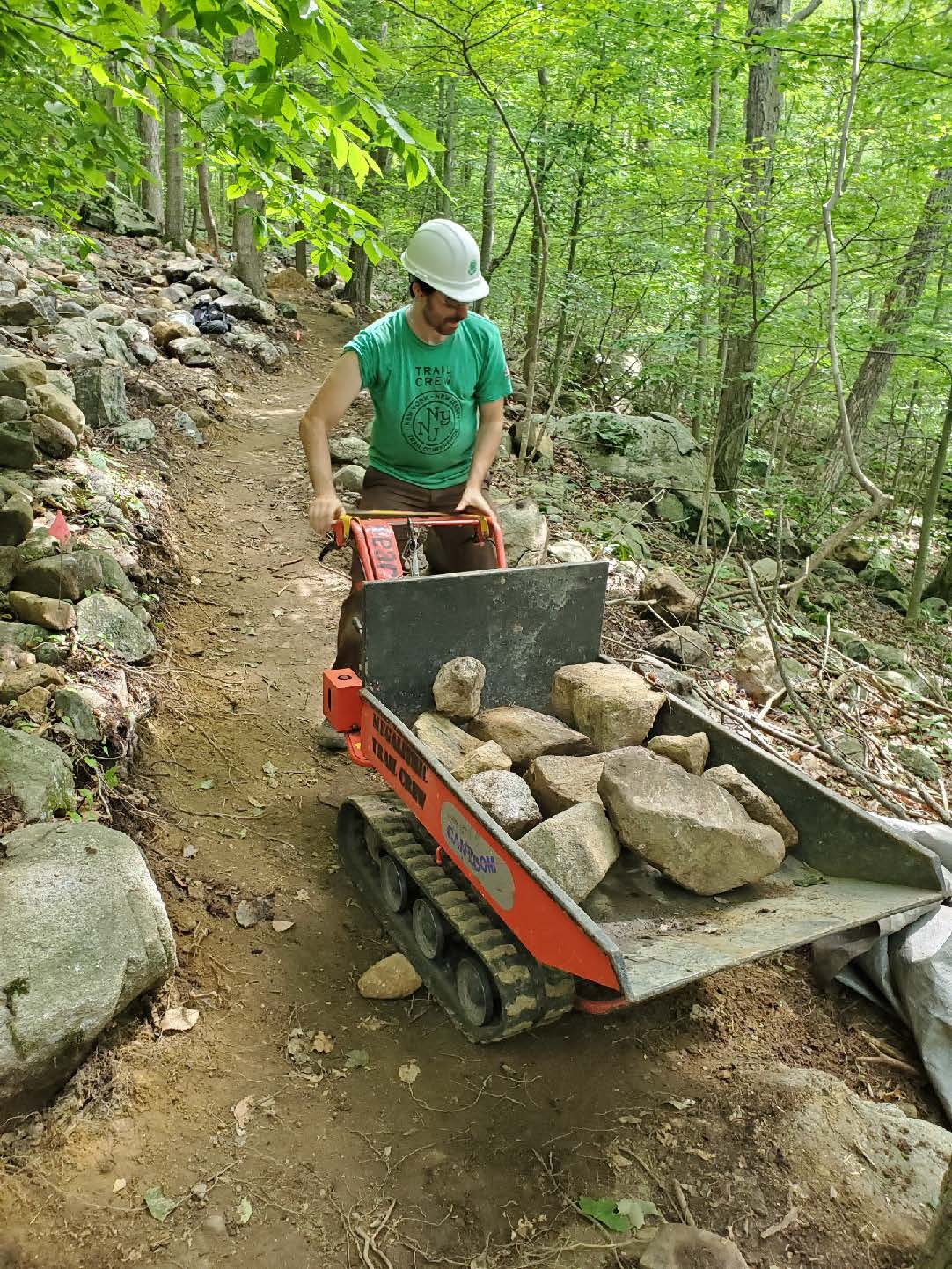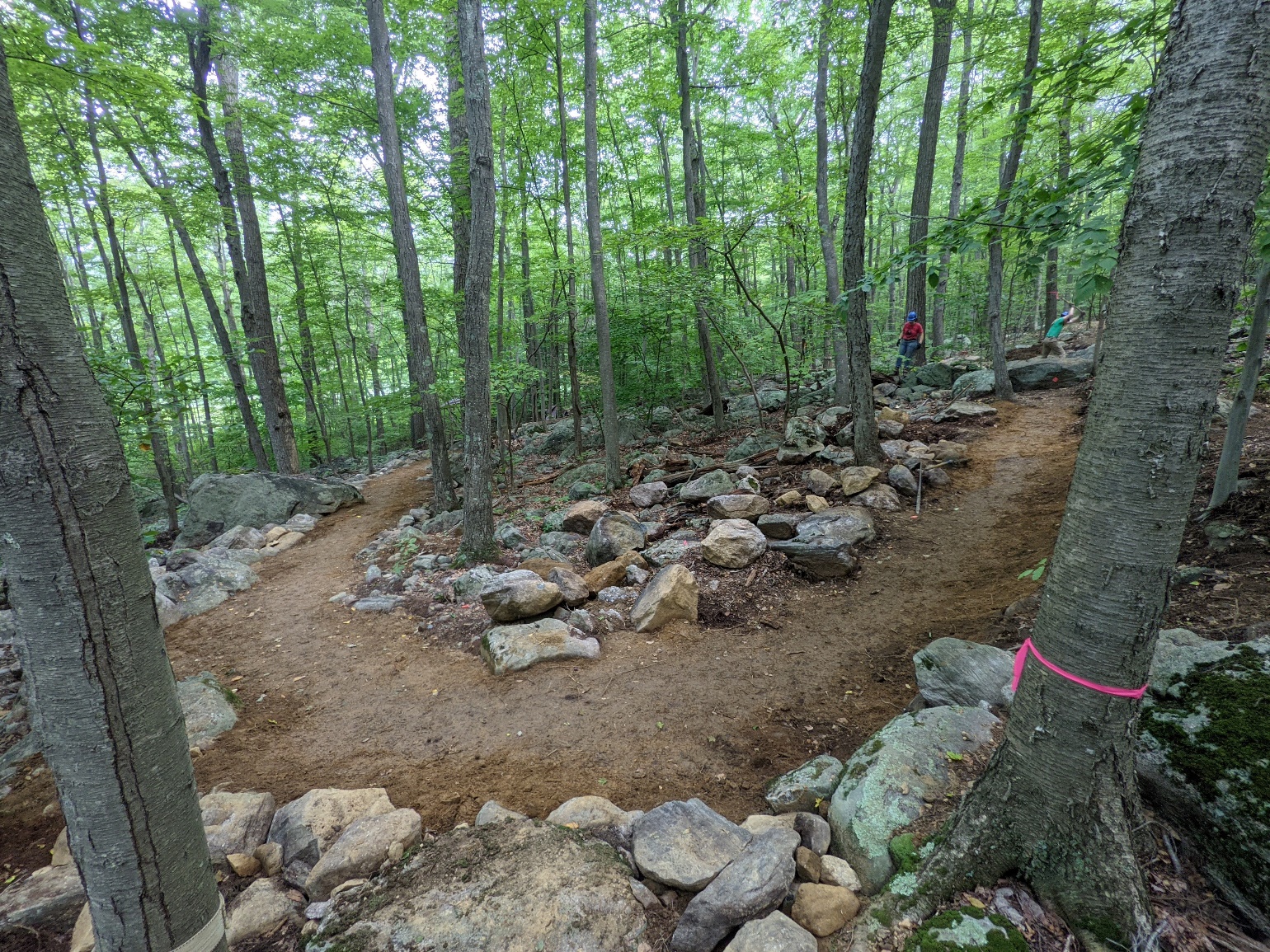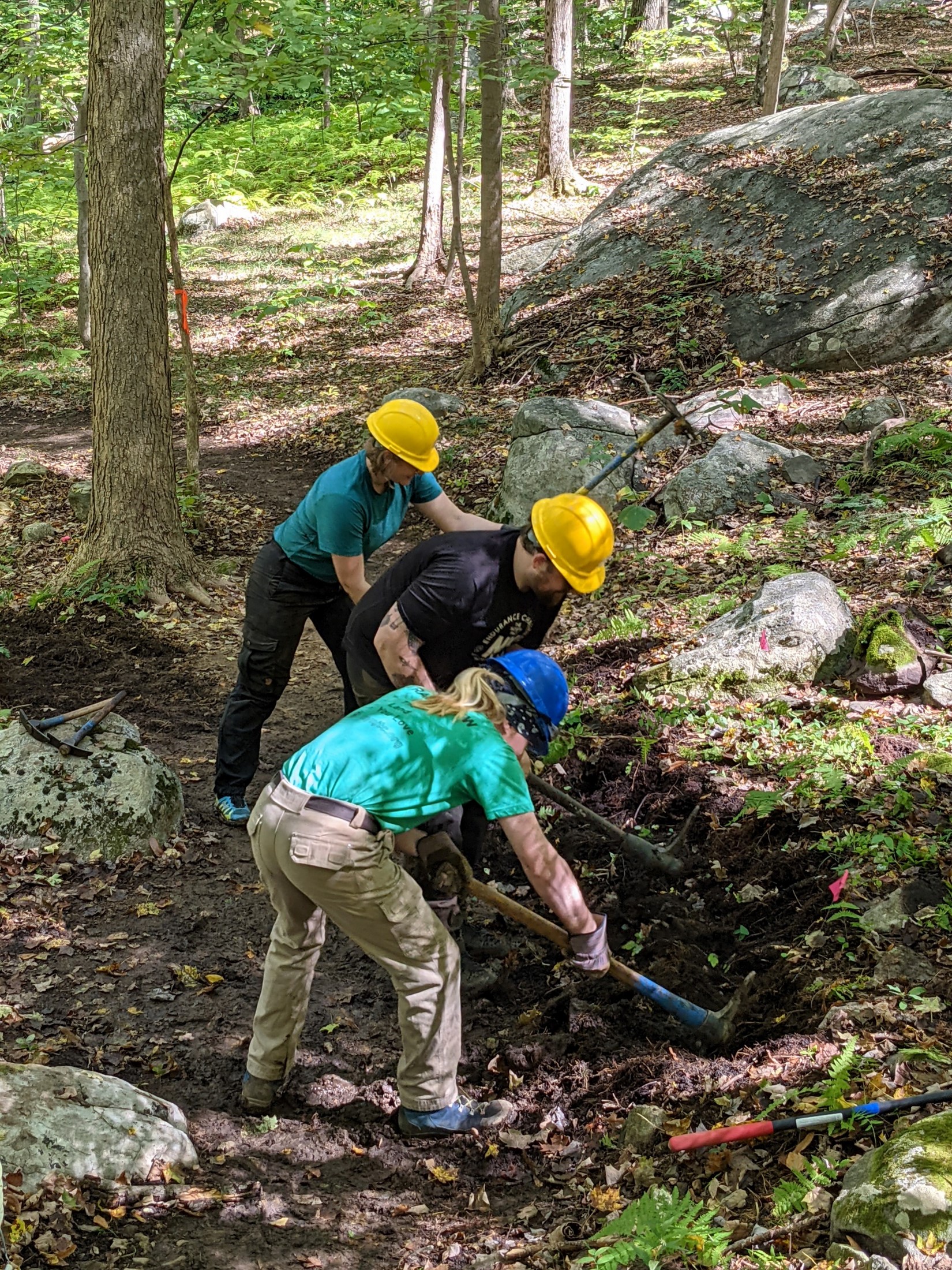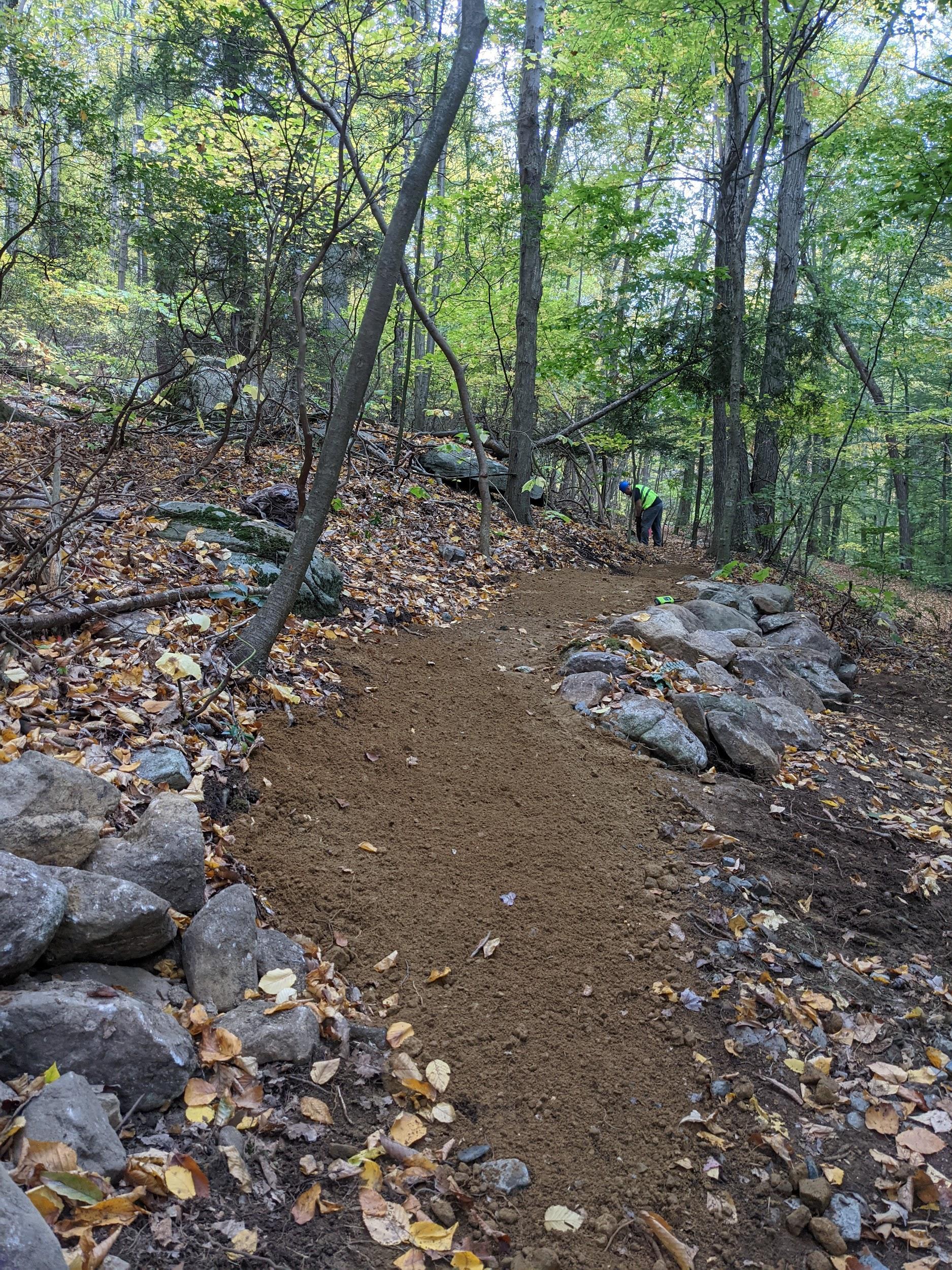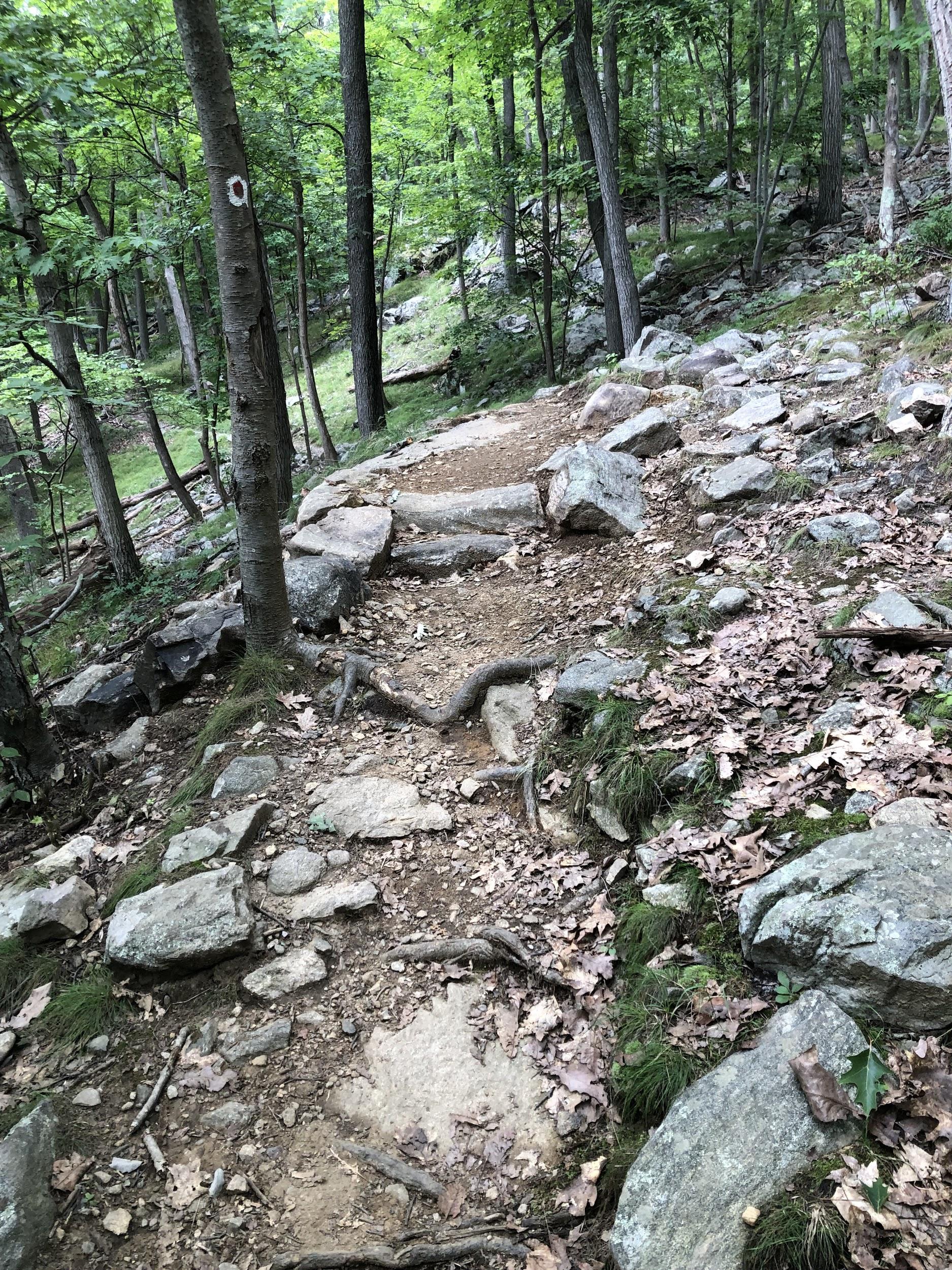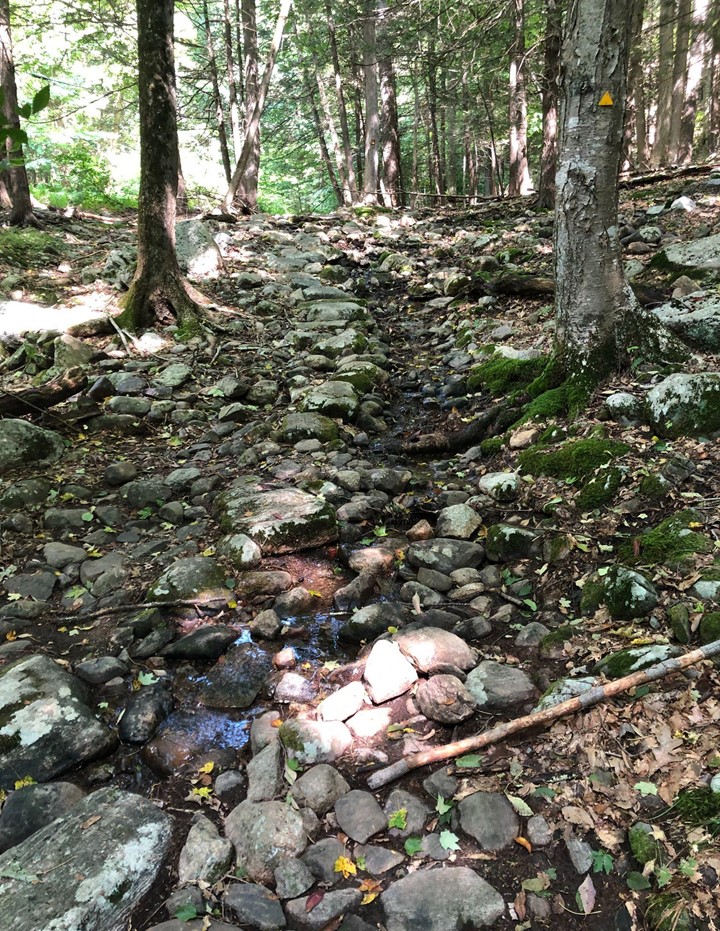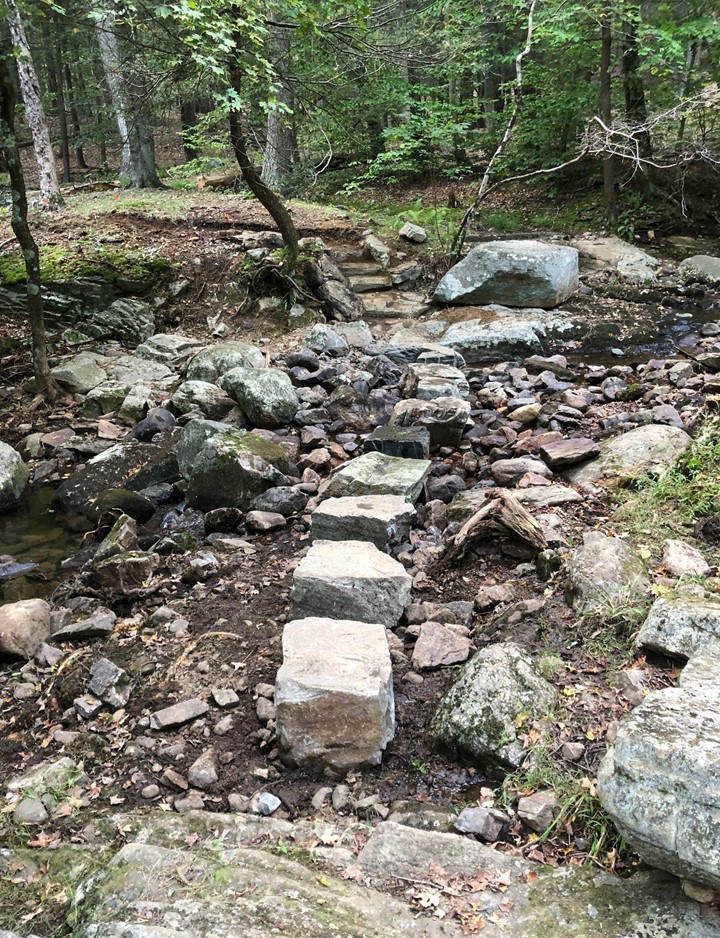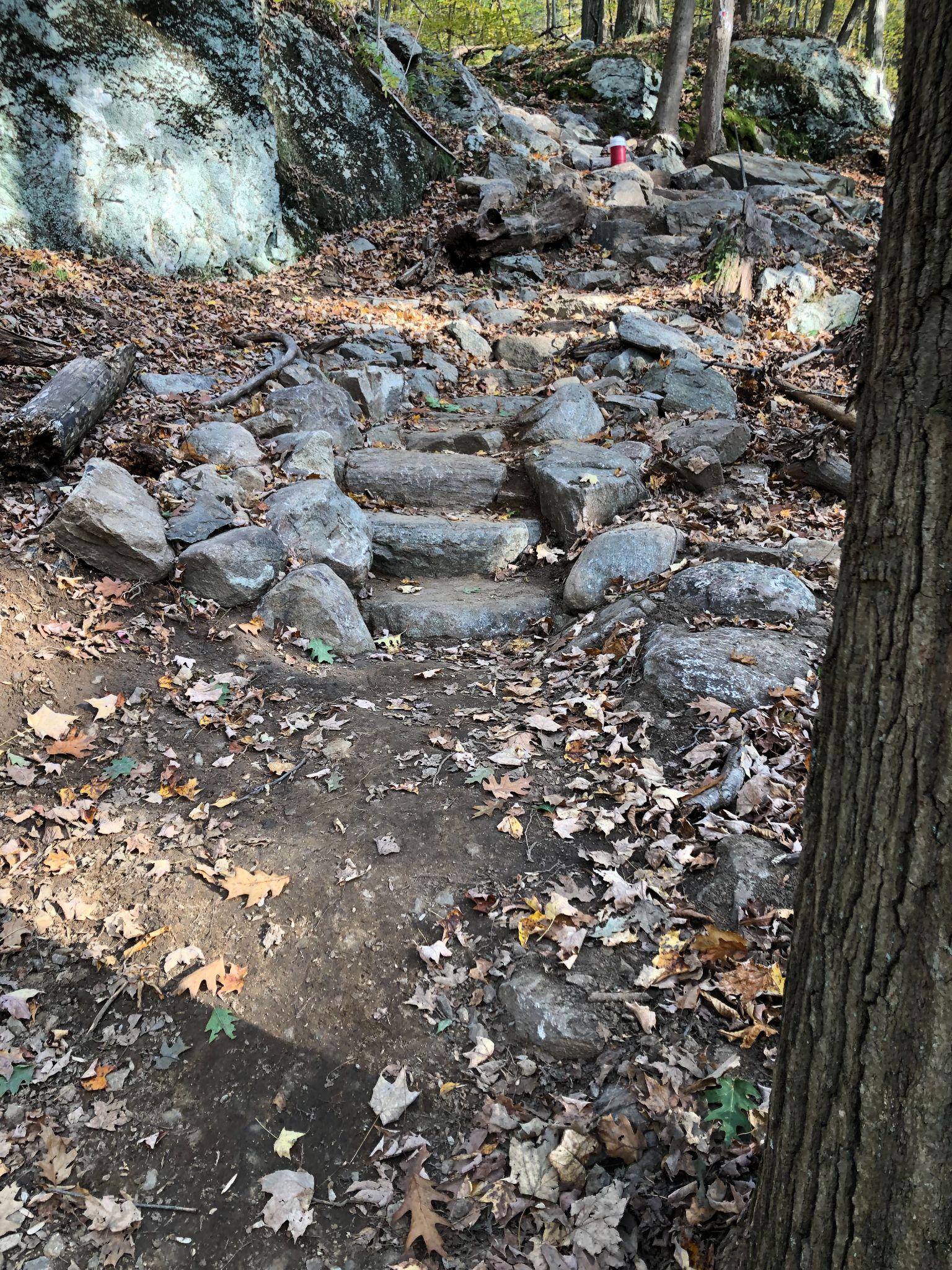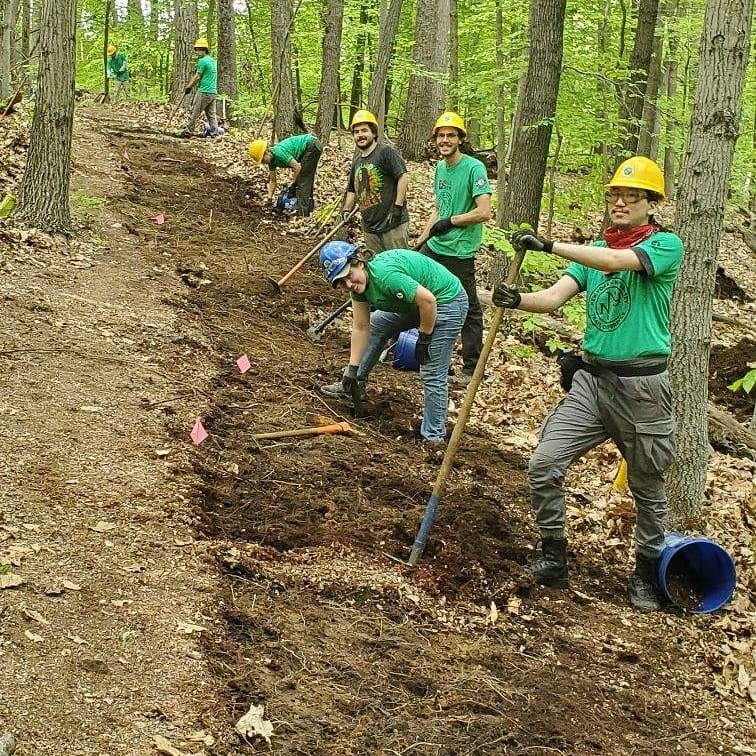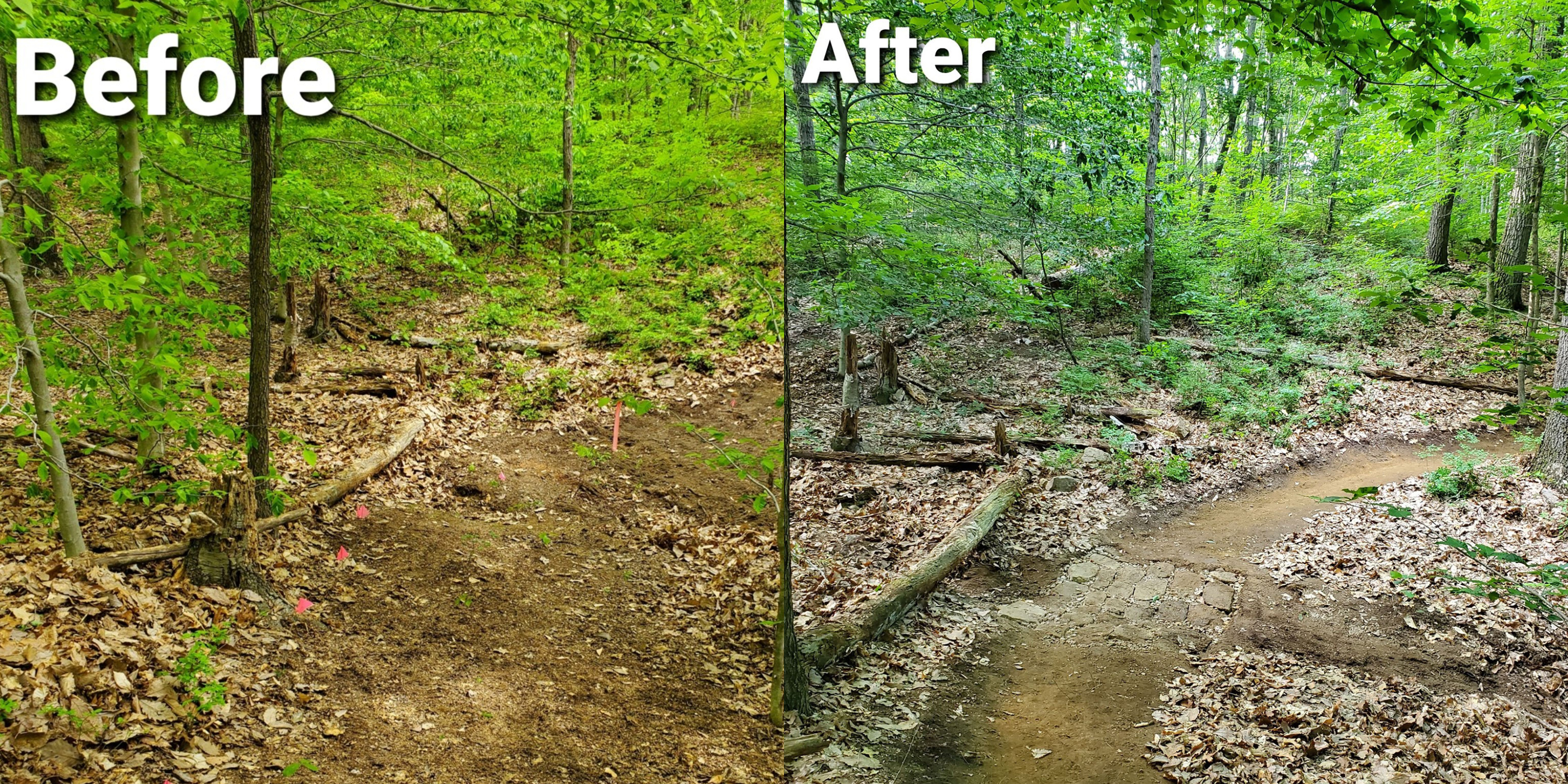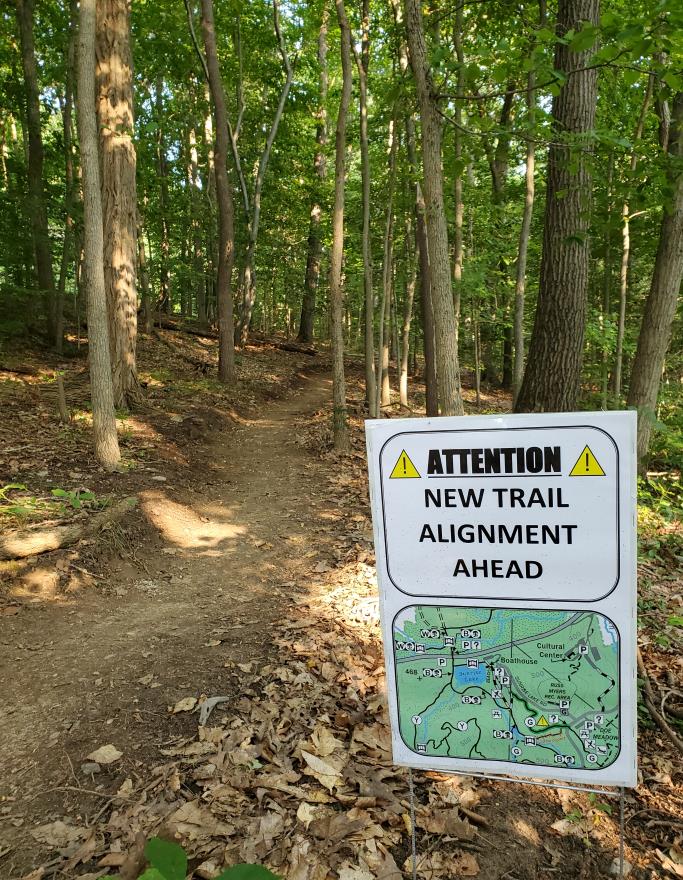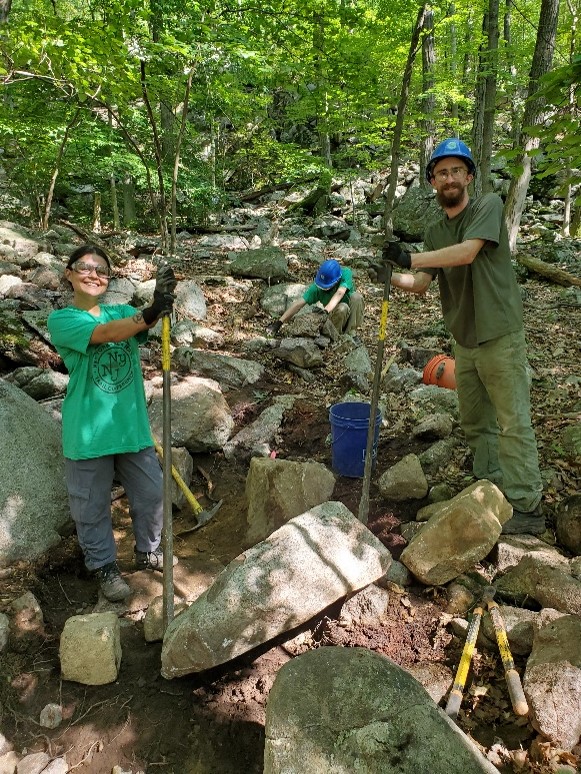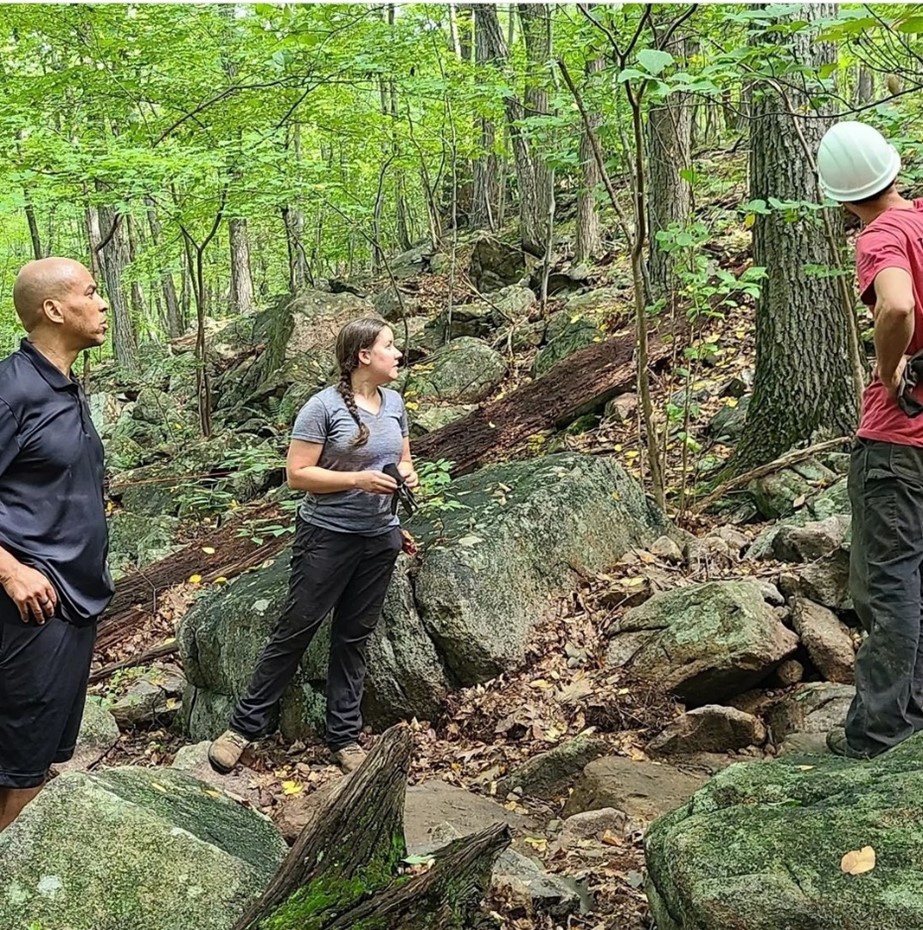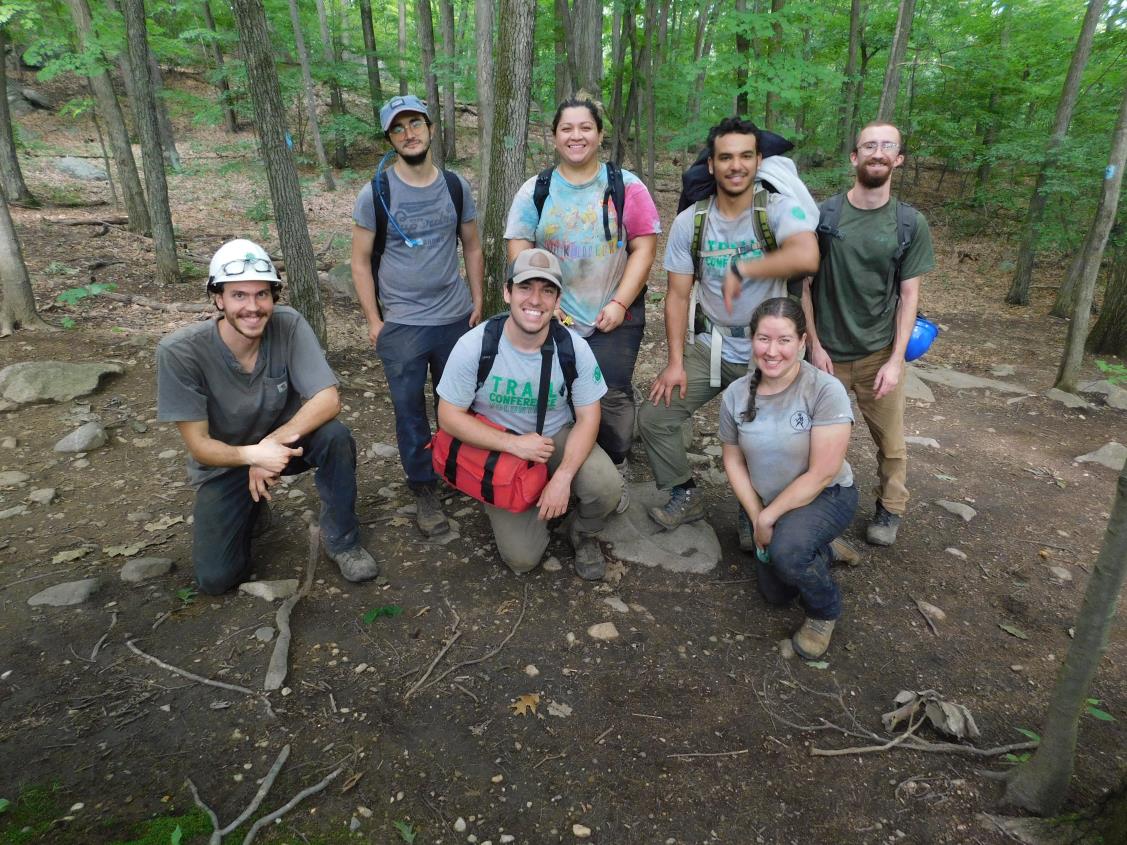The Trail Conference Conservation Corps’s Trail Crews, funded through diverse grants and donors as well as contracts with government agencies, build, renovate, and repair trails in northern New Jersey and New York’s Hudson Valley. They support the Trail Conference’s overall mission by using high standards and best practices to create trails that are not only safe, enjoyable, and accessible, but also durable and sustainable over the long term.
Table of Contents
Taconic Crews
April 2021 by Kevin Murphy, Morris County Crew Leader
Trail Crew Leaders Ed, Kevin, Bob, and Snowden leave April behind with their heads held high as they see through the completion of the Washburn Trail reroute in Hudson Highlands State Park, N.Y. This month concluded two years of work the Trail Conference Conservation Corps has made to create a sustainable trail to a popular viewing spot above the quarry overlooking the Hudson Valley. The original trail did not provide the users a clear path which caused dispersed masses to trample the surrounding precious environment and endangering the fence lizard population. To complete the reroute, this month’s goals were to construct a stone staircase and pipe culvert that crosses over an eroded gully leading to the viewing platform. This entailed quarrying and transporting stone via hand and grip hoist then installing the stones into structures. Snowden spent days methodically drilling and splitting the staircase stones to a suitable size where they were then transported to be installed by Bob and Ed. Kevin and Trail Builder Tracy focused on installing the culvert and wall often utilizing an aluminum tripod to position large capstones on top of the structure without unsetting and previous tiers. Throughout the month at Washburn, there were many unexpected events the crew faced, namely, the weather at the Washburn site, which some days saw gales of wind up to 40-50 mph and freezing April showers. The soil when wet creates a slick kind of mud which poses many problems when lifting and moving heavy material or equipment, so proper lifting technique and overall safety were a priority. Despite the obstacles encountered the crew was able to complete their work.May 2021 by Snowden Jones, Taconic Crew Leader
Our season has finally kicked off and now our fellow trail crew corps members have joined Ben, Tracy, the fellow crew leaders, and me. We started our month of training in Lewis Morris Park in New Jersey, teaching the crew members about trail reroutes, tool safety, and why we do what we do! The new Corps Members have learned plenty in their first few days and have shown us the amazing work they are capable of. We then made our way to the Washburn Trail in the Hudson Highlands State Park, the purpose of this visit was to show our corps members what a newly made set of trail and stone structures looked like. Kevin, Bob, Ed, and I were happy to talk about the processes that went behind obtaining the rock necessary to complete the stone staircases and culvert last season and the beginning of this season in April.After giving a thorough tour of the Washburn trail project, we proceeded to tool out all our equipment down the trail and to a new site just down the road. It was a bittersweet moment leaving Washburn trail, but I am quite proud of the work that was completed there. Afterward, we parked ourselves at the Sugarloaf Mountain Trailhead and headed up the Wilkinson trail. The first few hundred feet of the Wilkinson Trail were in desperate need of drainage structure repair and placement. The previous drainage structures were not sufficient for draining water effectively, so they were redone to better suit the needs of the trail. Aside from the drainage structure repair, there was also a section of trail that had been blocked previously by a tree. Since this tree was down and blocking the trail, trail users opted to choose a different path around the obstruction, causing an area to be disturbed and created a subsection of ‘new trail.’ As a team, we recognized this glaring issue and resolved it by re-naturalizing the area with rocks, leaf litter, branches, and ferns to hide the former hiker made reroute. Overall, in the days that we spent at the Wilkinson Trail, we completed 16 drainage structures and closed and re-naturalized 40 feet of trail. We continue to teach important skills to the corps members about rock moving and stone structure building in Harriman State Park and Sterling Forest. I am looking forward to getting back to the Wilkinson trail and completing more great work with my team as well as start the project up at the Undercliff trail in the coming weeks!
June 2021 by Snowden Jones, Taconic Crew Leader
In June, the Taconic Crew did a lot of preparatory work for the new additions that we would be making at the staircase on the Wilkinson trail. The crew drilled plenty of stair and gargoyle pieces upslope and then moved these rocks over to our highline. In using the highline, we utilized Leave No Trace principles to suspend rocks into the air to prevent further vegetation damage while transporting the rock. We experienced many issues in our initial trials of the highline, but I was very impressed with the level of problem-solving skills that the crew had when it came to resolving our issue. Their intuition helped us create a safe and effective highline to move the rock. These rocks are now by our staircase project as we now utilize them to add and repair the existing ones. We plan on adding 3 to 4 stairs to this staircase, this staircase has been particularly problematic as hikers typically avoid the stairs and opt to go around it. We are hoping that our renovation will help keep hikers on the trail and prevent further damage off-trail. The crew also managed to create more drainage structures and re-naturalize parts of the trail that had gotten widened due to the pandemic. Overall, the crew added 5 new drainage structures and naturalized 145ft and 3 inches of trail.
Our crew is also working up at the Undercliff Trail this season. We are responsible for putting in a new reroute, this reroute will be a stone staircase that connects to the Breakneck Ridge trail closer compared to the current trail. With the assistance of Evan Thompson of the New York State Parks Recreation and Historic Preservation, we were able to move our heavy tools a significant portion of the way up to our job site. Thank you, Evan! The crew and I have spent time de-duffing and moving rock in preparation for this challenging project, the weather has not really been on our side with the high temperatures and thick humidity, but we have persevered through it to get the groundwork of this project done. This will be a unique task where we will be implementing some techniques that I have not used before, stay tuned in future blog posts to hear more about it!
July 2021 by Snowden Jones, Taconic Crew Leader
The month of July has been a busy one for the Taconic crew, we have had multiple successful volunteer workdays and workshops on drainages and stone structures this month at the Wilkinson Trail worksite. The volunteers that have shown up have been highly motivated and interested in what we do as Trail Crew members. We got them involved in rock moving and staircase building, having very successful results in moving very large rocks for us to use as gargoyles in our staircase! With their help, we have plentiful amounts of rock to use as gargoyles and junk rock for closure that has helped us to finish our staircase! In total, we installed 3 new steps and repaired 4 stairs along the Wilkinson trail. We also ended up closing part of a social path that was confusing many hikers along the Wilkinson trail, closing 212 feet 4 inches of social path. The drainage workshop went well, having our volunteers learn about the necessity for drainages on trails and how to go about constructing them. We have also had the great privilege of having several New York State Parks department employees come out with us to learn about building trails and work closely with us to help at the Wilkinson and Undercliff trails. So far, the NYS Parks employees that have worked with us have helped install 6 new drainages along the Wilkinson Trail and helped us move the Jobox up closer to our worksite at the Undercliff trail.At Undercliff, we have finally finished digging out the area in which we plan on setting our stairs. This long stretch of area will require numerous steps to be set to achieve the proper elevation gain in the short path that we are creating. We are currently spending a lot of time making crush, moving rock into position, and drilling more rock to be made into stair pieces at Undercliff. And by the end of July, we have currently set 2 stairs and will be setting more very soon! After finishing our initial preparatory work for this new reroute, we are finally starting to bring rock over to the initial start of this new staircase.
August 2021 by Snowden Jones, Taconic Crew Leader
August has been a month of great success for the Taconic crew. We were tasked with adding a new set of stairs just above our first set of Wilkinson stair project. This staircase was an addition to assist with the elevation gain along this stretch of tread and help deter erosion at this location. We were able to source our rock from right near our Jobox and excess rock from our previous stair repair. This new staircase that we had installed has a total of 4 new stairs. We created a short crib wall off our staircase to uphold crush and the tread after the stairs, the length of this crib wall totaled 6 ft. Along with our brand-new stairs, we revegetated the areas around our staircases to keep people on the trails and promote regrowth. In total, we revegetated 197 square feet to clean up around our stairs and close down social trails created by users circumventing the old staircase. Now that we have completed our work in this area of the Wilkinson trail, we now make our way up trail towards a stream crossing where we will be installing steppingstones, more stone stairs, and creating new trail tread.At Undercliff, we are beginning to move up our set of stairs on our reroute to the junction with the Breakneck Ridge Trail. A large amount of work at this site before and during this month was spent drilling, splitting, and moving rock into position just above our worksite. Although we aren’t able to accommodate volunteers at such a tight worksite, parks employees and interns have been very helpful in moving and setting rock for the staircases Having finished the first set of four stairs, our crew is now beginning the next set, with 8 steps set total during August. Unfortunately, high water flows during and in the aftermath of Hurricanes Henri and Ida limited the number of days our crew could work at the Undercliff site this past month. Looking into September however, we are well-positioned to hit our stride and complete many more steps, with a goal of completing this project by the end of the season!
September 2021 by Snowden Jones, Taconic Crew Leader
The month of September was another successful month for the Taconic crew, we faced some difficulties at the beginning with hurricane Ida stalling our work at the Undercliff trail. The muddy conditions made setting stairs difficult for a couple of days. As we made our way up with our stairs, we had to take down a small tree because it was in the way of us setting gargoyles along our stairs. Overall, by the end of September, we ended up setting 7 new stone stairs on the Undercliff trail. We are more than halfway up the Undercliff reroute section and we are hopeful to set many more in October!
October 2021 by Snowden Jones, Taconic Crew Leader
For the month of October, we finished our season strong with a large number of stairs and other trail structures set at both the Wilkinson and Undercliff project sites. At Undercliff, we managed to set 26 stairs this past month as well as three separate platforms between staircase sections, a total of 6.6 linear feet. All that is left before we complete and open this new connection route with the Breakneck Ridge Trail is one final top platform and some cleanup/finishing touches. This should take place in early November, along with closure of the old existing trail junction.At Wilkinson, we got very close to finishing the stream crossing that we were working on. Overall, we installed another 5 more stairs at the stream crossing, completing one staircase on the North side of the stream and getting to near completion on the southside of the stream. We managed to finish the head wall we were working on near the stream crossing, adding an additional 19.1 square feet. Along with the stairs and steppingstones we added to the trail, we also excavated 34 linear feet of benchcut trail, part of a connection between the new stream crossing and existing trail. Finally, our crew also managed to de-berm the outside edge of 115ft of the existing trail to improve drainage. While this crew has completed their season of service, work on the Wilkinson and Undercliff trails is expected to continue with a new crop of Corps members in 2022.
Palisades Crew
May 2021 by Bob Delap, Palisades Crew Leader
Training DaysMay saw the arrival of the great bulk of the members, our 2021 Trail Conference Conservation Corps, and the beginning of their training. Very exciting! Training began for the Corps at Lewis Morris County Park in New Jersey, where bench-cutting was the order of the day. It can be a laborious process, clearing and cutting a new trail, but many hands make light work -- it's incredible to see how much new trail can be made by a large and motivated crew of newbies! With sore backs and blistered hands (repetitious swinging of hoes and mattocks can do that), some of the Corps members overnighted for the week in a group campsite in the County Park. After last year's COVID altered season, it was great to experience a little more camaraderie right off the bat.
After a few successful days in New Jersey, the Corps shifted over to New York’s Hudson Highlands. We Corps veterans got to show off last year’s successes at the Washburn Trail, but then began the painful process of packing out the tools and job box off the mountain (have I mentioned that many hands make light work?). We transferred those tools to the nearby Wilkinson Trail and got to work repairing old drainages. It was the Corps’ first insight into hiking in the COVID era -- trailheads were packed and people were out! We rubbed elbows with a volunteer crew and a professional crew working in the same area, and the Corps marveled at seeing some of their rigging and stonework techniques.
The next week, at Harriman State Park’s august Ramapo-Dunderberg trail, the Corps was trained in many of those same techniques. Stones abound in Harriman, and the Corps took to moving them, splitting them, and setting them with elan. It’s the area of trail work that most speaks to me; done right, the stones we set as steps or wall pieces will exist for generations. Harriman also happens to be my favorite park in the region; it’s where I learned to backpack. The sound of the roaring Thruway was something of a bother, but it was hard not to truly enjoy being at such a challenging site doing such interesting stonework.
Memorial Day came just at the right time, as the preceding weeks were trying. We hit the ground running, hard. In June, we will finish training at Sterling Forest (my site for the season), complete wilderness first aid training, and finally split into our designated crews. As the season begins in earnest, I’m impressed at the heartiness and resolve of our new Corps members. It’s not an easy vocation that they’ve chosen, and that fact is surely apparent by now. But they’ve quickly become seasoned and more knowledgeable, and it’s impressive.
June 2021 by Bob Delap, Palisades Crew Leader
Early June saw the end of our training schedule. I was happy to see that many of the skills we'd been drilling with the new Corps Members seem to have sunk in -- the crews moved stone and performed tread work with skill and creativity. Watching new Corpsmembers assess a large stone, excavate for it, wrap it, rig it, successfully move it into place, and set it in with crush, I am confident that there will be many more successes to report as the season rolls on.As the Corpsmembers then moved into their assigned crews, the numbers at Sterling Forest dropped from 20 or so to 4. The scale of the project suddenly became real to our crew, but we were resolute and unfazed. Sterling is peaceful with a smaller crew; no cell reception, no big crowds. We began plugging away at completing some of what the large training groups had begun.
And just like that, I was gone. I'm enrolled in a graduate program that required me to perform fieldwork in the Adirondacks for two weeks, so I had to leave my crew for a spell just as we were beginning. Bad timing, to have to be away just as the season was really beginning. But with trail crew veteran Kayla on the crew, I had little fear that our crew would be focused and safe in my absence. Upon returning, I was gladdened to see that the crew had completed some 60.5 sq. ft of boulder wall, and had begun creative tread work in order to adroitly obtain more necessary and valuable mineral soil. Looking forward, July promises heat and the help of volunteers.
July 2021 by Bob Delap, Palisades Crew Leader
The dog days came early this summer. A stretch of oppressively hot weather took its physical toll on the crew, but morale stayed high. A robust group of volunteers (including several friendly returnees) proved to be essential; with the massive amount of rock that needed to be moved, our small crew alone would have been working until next July! It really can’t be overstated how useful the eager hands of a volunteer can be, so thanks to those that turned out for us.
The main focus of our project at current, building boulder wall, isn’t complicated, it’s simply laborious. Unlike coursed crib walls, our boulder walls rely more on the sheer mass of piled stones than on engineering prowess. This is not to say it’s less skilled work. In fact, to efficiently move the stones, our crew and volunteers had to get pretty good with rigging and hand tool use, and quick! We finished about 64 square feet of boulder wall this month.What goes untold when describing crib wall is the great amount of fill required to bring the tread up to height. In our case, we’ve gone through several tons of stone just to elevate our tread anywhere from a foot to three feet. Thankfully, much of the stone was delivered to us by our Parks partners, but the great bulk was taken from onsite. This means walking around, finding rocks, picking them up, and throwing them in the trench. We do discriminate slightly, though, as not all rocks deserve a fate like this. While rock shopping, we came across a rock bearing several fossils. We took that one aside, and it enjoys a privileged position underneath our tarp.
It hasn’t all been too tough, though. A patch of wineberries on our hike in from the trailhead fruited for a few weeks. We did our part in fighting this invasive, and feasted.
In August, we should be finishing our boulder wall project and moving along up trail.
August 2021 by Bob Delap, Palisades Crew Leader
August saw something of a turning of the page. The Palisades crew finally began some finishing steps! Our massive boulder crib wall section was constructed, filled with many many tons of stone (native and imported), and, this month, covered with several inches of mineral soil. We had three sources of this mineral soil: 1). caches left over from the excavation that was performed earlier in the season, 2). new excavation of drainage dips throughout portions of the bench cut sections, and 3). borrow pits, a hole dug well off trail for the sole purpose of mining soil. Getting all that soil to the trail was often laborious. Luckily, we had several energetic and enthusiastic volunteers to assist us in the ungraceful act of carrying buckets. Eventually, we came around to rigging up simple zip-lines in order to fly buckets through the air. This carries the benefit of being safer, less physically taxing, and less destructive to the understory.Ben Sugar had rented us a plate compactor so that we might better pack down the stones and soil we were adding to the wall. This worked great for a few days until the new soil proved too dry to properly compact. This was ironically overcompensated for in the coming weeks, which saw two historic rain events hit the region. Much of the soil we took efforts to place had turned to muck! Luckily, the driving rain in fact compacted some of the soil anyway, so we were spared the effort. I was quite pleased to see that soil and material loss from drainage was minimal, suggesting that our design was sound.
We completed some 136 feet of formerly incomplete bench cut and began creating a wall to support a mountain bike berm. I’ll need to bring my bike out soon to test this new feature.
September 2021 by Bob Delap, Palisades Crew Leader
With the leaves just beginning to turn, our crew found ourselves working on a new section of the trail. Now mostly done with the lower climbing turn, we began to focus our attention on linking this year’s work with last year’s. The first crux of this linkage was a large boulder that was physically dividing the two sections; Ben drilled and split that stone, now creating a pinch-point and chicane to manage speed before the descent. The area also acts as a drainage dip, keeping water from entering the downhill stretch. When a day of rain arrived during our work week, we took the opportunity to renaturalize some areas that were impacted by our labor.Continuing up the trail, the crew constructed a small stone feature to ramp up to an earlier constructed table-top feature. This new construction replaced an off-camber stone slope with an evenly graded dirt slope. In the interest of keeping the trail fun for more intrepid mountain bikers, however, we left one-half of this feature still rugged and steep, created an A-line and a B-line.
The next section we tackled was just north of where the new route crosses the existing trail, which mainly consists of a trail that was roughed in early in the 2020 season but not finished. This involving both simple rake-and-go trail clearing and full bench cutting. Further down trail, and thanks to crewmembers on loan from Harriman and some hearty volunteers, we began the process of sorting out a few drainage issues that have been on the docket since last season. Creation of drainage lenses inside drains, and drainage dips were all the order of the day and should be completed shortly
Looking forward, the crew will be armoring some particularly crucial drainage areas, capping some rugged sections with mineral soil, and completing more bench cuts, then hopefully turning our attention to completing the stonework begun in 2020 to finish the connection with the Augusta Mine Trail. With the cooler weather, I anticipate the work to move quickly – especially as this will be the last month on site.
October 2021 by Bob Delap, Palisades Crew Leader
The last month of the season with the full crews saw both finishing touches being done and new construction taking place.A wet section of trail has been a problem for some time, and this month we tackled it. The crew elevated the tread using stone cribbing, crush fill and mineral soil, while digging an inside drain to further remove water from the treadway. Normally a trickle of groundwater, an autumn storm put the infrastructure to the test and, after some minor improvements, the wet area seems to be greatly improved.
In same area, we created a small stretch of drainage lens as well, allowing trickling groundwater to move beneath the elevated treadway.
Further down trail, at the nexus of the new reroute project and the existing trail, we found that the connecting slope was unfortunately almost entirely unusable organic soil. So, we needed to build up and wall in order to hold up the hillside and the new fill. The construction was a hybrid boulder/coursed wall -- even using irregularly shaped boulders, we still were careful to brake joints and build in rudimentary tiers. The wall overall measured about 50 square feet.
We hosted a final workshop, focussing on tread construction and repair. With the willing volunteers, we did some finishing treadwork and drain digging, a useful exercise for both water removal and harvesting of mineral soil without having to dig a borrow pit.
Harriman Crew
May 2021 by Ed Zubrowski, Harriman Crew Leader
Throughout May 2021, I worked on the start of the Ramapo-Dunderberg Trail at the southern end of Harriman State Park. The Ramapo-Dunderberg Trail is the oldest trail in the park and it definitely shows based on the condition of the trail. The beginning section is braided with social trails due to sections of rock staircases becoming unusable. The start of the trail also floods pretty significantly even with light rain. The entire Conservation Corps was with us this month and we all worked on separate sections of the staircase. Most staircases had either fallen apart or had become inconvenient to use due to erosion and compaction of the trail tread. The section I worked on, along with several other corps members, is right at the start of the trail. This staircase is the first thing people will use when they step on the trail, so the steps needed to be large and inviting. Most steps on the Ramapo-Dunderberg Trail are around 24-inches wide. The steps I used for the start were 36-inches wide which is around the size we used for the Washburn Trail that experiences a lot more foot traffic. Setting large steps in Harriman on the Ramapo-Dunderberg Trail is especially challenging due to the very rocky soil and often very wet conditions. The rocks make for slow digging and the water turns everything into mud. The Ramapo-Dunderberg Trail is a very historic trail and I”m happy to give it the improvements it deserves.
June 2021 by Ed Zubrowski, Harriman Crew Leader
Throughout June 2021, the Harriman Trail Crew completed the set of stairs at the entrance of the Ramapo Dunderberg Trail. This set of stairs was especially difficult because we were starting on the edge of a service road that we couldn't block access to. The top of the staircase ended at a section of bedrock so we had to squeeze 8 steps with 9 inches of rise each into about 100 inches of run. To accomplish the squeeze, our last step was pieced together with two rocks that we had to shape to fit the bedrock. After completing the staircase, we focused our efforts on re-naturalizing the area. We created boulder walls to prevent people from going off-trail to use an old woods road that was once part of the trail. Further up the trail, we set 6 steps along another section of bedrock that ran along the inside edge of the trail. Setting against bedrock is always a challenge and we were forced to chip away at our stairs and the bedrock to lock everything in place. Continuing up, the trail turns and we added several steps and closed off social trails alongside the steps. The previous section of the trail was poorly defined so adding the steps at the turn and defining the tread should help hikers find their way. The final section we worked on this month involved repairing an old set of steps. The area had multiple social trails due to several steps that had become unset. Two steps had over 11-inch rises which are way too tall for people to use willingly. We re-worked the steps and added better gargoyles to lock them in place. We ran into a large section of bedrock towards the top of our staircase so we decided to incorporate it into the stairs instead of trying to set steps on top of it. Two of our steps were set on the bedrock so we used an angle grinder to carve out a lip for the steps to sit behind so they wouldn't shift out of place over time. We closed off all the social trails near this staircase as well as social trails along the way to the Triangle Trail-Ramapo Dunderberg trail junction. The Harriman Trail Crew accomplished a lot this month and I’m excited to start work on the Triangle Trail in July.July 2021 by Ed Zubrowski, Harriman Crew Leader
In early July, the Harriman Crew began defining a section of the Ramapo-Dunderberg (RD) Trail that runs along a section of bedrock. We added two steps on top of the bedrock that led into a small section of trail held up by a crib wall. The stairs make it so people approaching the bedrock from downhill can clearly see which direction the trail goes. Before installing the steps, the trail branched off into social trails from unsure hikers trying to find the trail. Installing the steps and crib wall on the bedrock required many hours of angle grinding and chipping away the bedrock to make the steps stable. The crib wall rock was fit into notches cut out of the bedrock to help prevent the rock from shifting overtime. On the opposite side of the bedrock hill, we set three more steps to prevent erosion of the tread as well as help show hikers the right way to go. To set the steps, we had to angle grind and chip out more bedrock until the steps were stable.Further up the trail where the Triangle Trail starts, we started working on a staircase that leads up the RD. Hikers often miss the turn onto the RD and continue onto the Triangle Trail. Before adding the staircase the RD was poorly defined. Hikers wouldn’t recognize the rocky hillside as a trail and would end up making their own trail to connect the RD and Triangle Trail. With the addition of the stairs and the newly defined tread, hikers will be less likely to miss the turn.
The first few steps were difficult to set due to unexpected bedrock outcroppings just beneath the soil. We used the angle grinder to remove large amounts of bedrock to make room for the steps. Down the Triangle Trail, we began work on improving and installing waterbars. We got a large jump on the work with the help of five volunteers that came out for a work trip. The volunteers helped quarry rock, collect mineral soil, and set rocks for the waterbars. Building water bars isn't as glamorous as building staircases but it's still important work. The water bars prevent water from running down the tread and picking up speed. By shortening the distance the water can travel, we lessen its power, therefore decreasing its destructive force on the trail tread. As we continue improving the RD and Triangle Trail, we hope to increase the sustainability of these trails. Throughout August we will continue to improve drainage structures along the Triangle Trail as well as build structures to help cross rivers and wet, low areas.
August 2021 by Ed Zubrowski, Harriman Crew Leader
At the beginning of August, the Harriman crew finished setting the last few steps at the junction of the Triangle trail and Ramapo Dunderberg trail (Figure 1). Along with tread definition, this staircase helped better define the junction and guide hikers. We then moved our job box half a mile down the Triangle trail to a small creek crossing where we began work on an open culvert to replace the old timber bridge. Building the open culvert required quarrying rocks about 150ft upslope that we then flew down on the high line. We chose large rocks that will remain in place during peak flow events for the creek. Digging holes and setting rocks was a challenge in this area due to the holes filling with water immediately.
Further up the Triangle Trail, we finished constructing water bars along a very steep section of the trail. We also cleared out channels in between existing causeways to help water stay off the trail. There were many drainage issues along the Triangle Trail that became evident after the heavy rain from the tropical storms. We defined drainage channels across the trail to guide water across and off the trail so it wouldn’t pool up on the tread. We also outsloped portions of the tread by removing berms that have built up over the years to allow water to flow off the trail. Another section of the trail had an existing drainage channel redefined and stepping stones along the channel stabilized to keep the trail issuable during wet conditions. Most of the work on the triangle Trail has been small to medium-sized drainage structures so it will be exciting to move onto the large river crossing in September.
September 2021 by Ed Zubrowski, Harriman Crew Leader
During the month of September, the Harriman trail crew completed a set of stepping stones on the Triangle Trail across Deep Hollow Brook. The river is mostly dry in the summer months but flows heavily in the late winter/spring and after storm events. These will allow people to cross during the times the creek is significantly higher, and moving the crossing spot roughly 15 feet downstream moves the northern part of the crossing off of slippery bedrock frequently wet from a nearby seep.
Exposed rock near the river crossing was scarce so we had to quarry rock downhill of the site. After spending three days drilling and splitting large boulders into manageable stepping stones, we had to grip hoist the rocks uphill. We used a combination of rock bars and flipping by hand to stage the rocks under a highline we had set up. We sent fifteen large steps and stepping stones across the river and staged them on the bank where we planned on benching in the new section of trail where the stepping stones would lead to. Any large trees near the crossing were dead or dying and couldn't safely support a highline. We ended up using some smaller trees and keeping the line low but we needed a capstan winch to assist in pulling the rocks across the line. Usually, you set up a highline with one end higher so gravity can move the rocks across the line but we couldn’t adjust the heights of the spars without crashing rocks into the river bank.After sending the rocks across the river, we moved the stepping stones into the river by hand and leveled them out in the stream bed. Two of them were set on bedrock at the edge of the brook and had to be pinned in place to prevent them from shifting during peak flow events. We added three steps in the bank leading out of the channel to prevent the bank from eroding when people enter and exit the river (photo on right) and cleared/excavated the approach tread on either side.
Working to set rocks in the river was challenging but it was nice to get experience working in a new environment with new obstacles to overcome. And despite our crew now being down to 3 members, we continue to get solid work done.
October 2021 by Ed Zubrowski, Harriman Crew Leader
During the month of October, we spent our time working on the Ramapo- Dunderberg Trail in Harriman. Alongthe Ramapo-Dunderberg Trail Our crew added a base step and four riserss to the bottom of an existing staircase that
was getting undermined due to steep slopes and the amount of hikers that come through the area. The added
stairs will prevent erosion at the base of the main staircase, extending its life.
Farther up the staircase we added gargoyles along the outside and the inside of the current staircase. These will prevent erosion along the side of the stairs and help hold them in place overtime, and provide a valuable feeling of safety on the edges of steps for hikers descending.
At a bend in the staircase, we added gargoyles to form a water bar along the outside that will divert water from
a seep above the trail. The seep flows heavily after rain and causes the stairs to become slippery or icy depending on the
season.
The water bar will help keep the water off the stairs. At the top of the stairs, we added extensions to existing
stairs that were either too short or half steps to help backpackers up stairs with a high rise. We also internally pinned
stairs on top of bedrock to help keep them in place over time.
Morris County Crew
May 2021 by Kevin Murphy, Morris County Crew Leader
Trail Crew Trained to Construct Sustainable Trails at Lewis Morris County Park
Trail Crew Members started their season training at the Green Trail in Lewis Morris County Park in Morristown, N.J. The goal of the project was to reroute a section of the Green Trail that had several problems including erosion damage due to steep trail grades and trail braiding, or splitting into two paths, as a result of not properly excavating the tread to provide a durable and defined surface for users. In this case, the problems of the original trail were too extensive to mitigate, and it was decided to reroute the trail. This was our Crew Members' first time on the job site so, before we got to trail constructing the staff and Crew Leaders informed Members about general tool identification, handling, and safety, as well as site safety concerns. From then, Trail Crew Members were educated on how to construct a sustainable multi-use trail. This involves what we call bench cutting or, excavating down to the mineral soil, which will compact and provide a durable walking or biking surface, as well as “out-sloping” the trail to keep water flowing off the trail to prevent erosion. Some Crew Members had a hard time wrapping their heads around the concept of bench cutting construction because it can feel a bit overwhelming sculpting back a lot of soil and roots. However, once their work areas were cleaned up and started to take shape many Members could see the impact and craft of the work they had signed up for. Over the three days of training at Lewis Morris County Park Trail Crew constructed 463 linear feet of new trail.Now that the training period has come to an end our Trail Crew Members are knowledgeable in sustainable tread construction. The Morris crew will be working on completing the Green Trail reroute until late June with volunteer crews set to assist in construction on certain weekends. Morris Crew is looking forward to our next projects which will include a short reroute of a multi-use trail at the Tourne County Park in Boonton, N.J. followed by rerouting a popular trail in Pyramid Mountain in Boonton, N.J.
June 2021 by Kevin Murphy, Morris County Crew Leader
Morris County Trail Crew Constructs New Sustainable Trail in Lewis Morris Park
I am grateful to lead the Morris Trail Crew in the construction of one of Morris County Parks Commission’s newly designed sustainable trails. This month our crew accomplished constructing 694 linear feet of new multi-use trail in Lewis Morris County Park. The Assistant Superintendent of Trails for the Morris County Parks Commission, Amy Lutsko, who has been replanning Morris County parks using sustainable practices that are user-friendly, enthusiastically referred crew leaders and volunteers from JORBA (Jersey Off-Road Bicycle Association) to use our work as a template for how to build a sustainable trail. The crew felt a new sense of positivity that their work would be educating the local mountain biking and volunteer community. JORBA volunteers have been busy constructing a new sustainable route in the Tourne County Park in Denville, N.J. and we hope that our work inspires them to put a similar amount of effort and detailed care into the building. I was proud to see the Morris Crew put energy into fine-tuning sections of trail to finish it, as this can sometimes be a step glossed over to move onto bigger and bolder projects. However, great care was put into properly out-sloping, and de-berming the tread to accommodate drainage.Although the trail was designed to be sustainable, even the best-designed trails can suffer from issues that require intervention, such as building structures. There were sections on the flagged out Green Trail there were suffering from drainage issues, most likely from heavy runoffs from the road above the trail. One area was addressed by installing a 35 sq ft armored drain swale which acts like a cobblestone walkway that is out-sloped to accommodate erosion and directs water off-trail. Another section of the trail crossed perpendicular to the drainage trench where the trail dipped down into the trench, and for users to be able to smoothly climb out of the trench a 9 sq ft retaining wall was built to make grade. During the installation of the wall and armored drain, I took an opportunity to train the crew in basic principles of dry stonework that will become more relevant and essential to the Pyramid Mountain project next month.
This month the crew became comfortable in the principles and construction of sustainable tread. They learned basic rules for dry stonework that will be refined in the weeks to come. Looking forward, there are many sign-ups for our July volunteer workshops at Pyramid Mountain that the crew and I happily anticipate! Morris Crew will be completing our section of the Lewis Morris Green Trail by early July and will be moving on constructing a section of the brown trail in Pyramid Mountain.
July 2021 by Kevin Murphy, Morris County Crew Leader
Morris Trail Crew Completes Reroute in Lewis Morris County Park and Begins New Reroute in Pyramid Mountain
In two weeks, our crew completed the multi-use Green Trail reroute in Lewis Morris County Park by constructing 494 linear feet of new trail, installing a 25 sq ft armored drain swale, as well as removing 3 blowdowns. The crew became much more confident in their abilities to sidehill trails and educate the public on sustainable trail construction. Trail Crew Member Sofia Salcedo had a leap of personal growth this month not only as a trail builder, but as a volunteer leader. She is quick to adapt to the unforeseen challenges this role presents while being skilled in basic construction techniques and communicating to volunteers in a fun way. The crew came away from the Lewis Morris project feeling accomplished that their hard work was being appreciated by the community of enthusiastic mountain bikers and hikers. After our work at Lewis Morris was finished, we packed out to Pyramid Mountain Natural Historic Area in Montville, NJ.
The scope of the Pyramid Mountain project is to reroute sections of the Blue Trail that are suffering from issues like erosion, undefined tread, braiding, and hard-to-navigate sections of boulder scramble. Our crew is constructing a reroute of the Blue Trail that will connect from the Orange Trail, on the southwest end of the mountain, to the Yellow-dot and Blue-dot Trails, getting hikers to an overlook and near points of interest such as Tripod Rock. In the future, parts of the current Blue Trail on the southwestern end will eventually be closed and naturalized due to the previous issues mentioned that are beyond repair. The build at Pyramid is significantly different than my crew’s previous work at Lewis Morris, namely the users, and their expectations, as well as the terrain and design. Pyramid Mountain has hiking-only trails that are rugged and rocky. We want our work to match the existing trails to meet user expectations but to build them in a way that is more friendly to navigate. This was a challenging concept for the crew, who had just come from constructing a multi-use trail that had very little rocks in the soil, where most of their work consisted of sidehill bench cutting.
The initial layout of the Blue Trail reroute connects east of the Orange Trail to an unmaintained trail, the old Red Trail, where 106.5 linear feet were improved to be incorporated into the reroute. This included trail corridor clearing, smoothing out protruding rocks and roots, and side-hilling to make a more friendly stepping surface. As the reroute ascends the mountain, there are a few rocky talus slopes that the layout incorporated. To make these steep boulder fields sustainable, safe, and navigable, they required hardening with stone steps. This project so far has been a great exercise in layout and design. I tried my best to design the first section of steps utilizing natural large talus anchors to give the steps a feeling of belonging there, which will helpfully encourage users to stay on the trail. This month we installed 4 stone steps and constructed 815 linear feet of new trail at Pyramid Mountain. We were very grateful for the 86+ volunteer hours recorded this month and look forward to engaging with the community more on this project.
Next month the crew’s main goal will be to install more stone steps and define the trail corridor as we ascend Pyramid Mountain. We aim to open the Blue Trail reroute by the end of the season.
August 2021 by Kevin Murphy, Morris County Crew Leader
Pyramid Mountain Brown Trail Construction Continues
To recap Morris County Trail Crew’s work from last month at Pyramid Mountain Natural Historic Area in Montville, NJ: The crew is constructing a reroute of a western portion of the Blue Loop that connects the southwest Orange Trail to the Yellow dot and Blue dot Trail allowing hikers another route to ascend the mountain to reach points of interest.
As the Blue Loop ascends there are three distinct talus fields that are too steep to be sustainable tread, so we are constructing stone steps where necessary to provide a hardened tread surface that is hiker friendly. This month we set 15 steps and built 12 linear feet of the stone turnpike in the first talus field. When building structures there is always a sustainable trail design risk that users will tend to avoid walking on structures. To keep hikers on the trail the crew revegetated around steps with native wild blueberries as well as naturalized areas with logs and stone. Climbing up before the first talus field the grade was sustainable but, to make the trail more defined and navigable the crew bench cut 136 linear feet of new trail. In this benched section the crew blocked parts of upslope with logs and debris to keep hikers on the trail. Approaching the Yellow dot and Blue dot connection from the third talus field the crew along with our amazing volunteers cleared the trail corridor and defined a flat section accounting for 238 linear feet of new trail built. More highlights from August include naturalizing 101 linear feet of a section of an unmaintained trail- the old Red trail. The Blue Loop reroute design will incorporate sections of the old Red Trail before climbing the talus fields. In some cases, sections of the old Red Trail had to be rerouted or defined.The crew has been grateful to have an enthusiastic volunteer turn out this month resulting in large sections of trail corridor clearing as well as finishing definition on tread surfaces. Although progress is steady, the greatest challenge my Crew Members face ahead is stone staircase design and construction. We aim to have the rerouted section of the Blue Loop open before the end of the season.
This month the Morris County Trail Crew continued construction of the Blue Trail reroute in Pyramid Mountain Natural Historic Area in Montville, N.J. The crew carried on improving sections of the unmaintained trail that are incorporated into the reroute where 505.5 linear feet of old trail was improved. This included smoothing and defining the tread, and in some cases, removing or reorganizing protruding boulders to make a more navigable path. 23 linear feet of trail was naturalized on a braided section of the unmaintained trail to dissuade further user impact. Branching off the unmaintained trail and ascending to the first staircase 119 linear feet of new trail was constructed by side-hilling and smoothing the tread. The crew installed 5 more steps and 6.5 linear feet of the turnpike on the first steep talus slope scaling the mountain. Breaking up the normal construction routine, on Sept. 18th the crew greeted Senator Cory Booker, Trail Conference Staff, and a group of guests on-site to explain our role and details inside the project. The group hiked through the not-yet-completed Blue Trail reroute and got to experience both sides of a roughed-in trail concept versus fully completed sections. The Senator and his guests were very appreciative of the mission and work we had put in so far. On September 25, the crew participated with our partners at the Morris County Parks Commission in National Public Lands Day at the Tourne County Park in Denville, N.J. The crew led 2 groups of 10 volunteers to clear the trail corridor on the Purple Trail reroute, while Trail Conference Field Trail Builder Tracy Arcella led 2 groups of 10 volunteers, including members of JORBA, to finish the orange trail connections on both ends. Next month we will sharpen our bevels, brush the rust off our rock bars, and march ahead with the Blue Trail reroute at Pyramid Mountain. Morris County Trail Crew has been diligently finishing out this season’s construction of the Blue Trail re-route in Pyramid Mountain Natural Historic Area. We accomplished installing 6 stone steps and 4.3 linear feet of platform that ascend a steep talus field. The crew along with groups of our incredible volunteers helped build 372.1 linear feet of new tread which included side-hill construction, as well as some rock rearranging and soil capping. The crew and I are thankful for our volunteers who put it 90 hours of trail work on the project this month. Throughout the season this crew has met challenges that interfered with our goal of completing the re-route by the end of the season, but we liked to stay ambitious. Though we were down a crew member since mid-July and I unfortunately had an injury this month that limited my ability to be on site, the crew has accomplished a nearly completed re-route which next seasons Corps Members will take the reins on. Future work will entail hardening two more steep talus fields with stone stairs. At the end of this month, we said goodbye to our 900-hour Conservation Corps Members. I was grateful to have Derek Barney and Sofia Salcedo as crew members this season. They each brought their own unique value to the projects and took pride in quality trail work. To my great pleasure, Sofia and Derek became more independent and confident in all the skills taught to them since the beginning of the season. I have much gratitude for them as well as Trail Conference Field Trail Builders Tracy and Ben for picking up the slack while I was out recovering. Going forward, a new crew of 300-hour Corps Members will begin construction at Schooley’s Mountain Park in Long Valley, N.J. through the end of the year.
